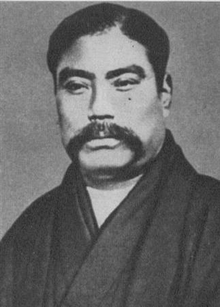Iwasaki Yatarō
Iwasaki Yatarō ( Japanese 岩崎 弥 太郎 ; born January 9, 1835 in Aki in the province of Tosa ; † February 7, 1885 ) was an influential Japanese entrepreneur. He founded in 1873 the company empire Mitsubishi .
Live and act
Iwasaki Yatarō was born as the eldest son of a farmer in Aki, Tosa Province, because his grandfather had sold his samurai status to pay off debts . Since this status was a prerequisite for a position in the administration of the domain, he bought the status of an impoverished samurai at the age of 20, that of a gōshi (郷 士), so that he now had at least the lowest rank. At the age of 19 he followed a member of the Tosa clan to Edo for further studies. But only a year later he had to return because of a serious injury to his father. A dispute with local authorities subsequently led him to prison for seven months. He later studied with the well-known reformer Yoshida Tōyō. Through Yoshida's connections, Iwasaki got a job with the Tosa Clan and was able to buy back his family's samurai status. After Yoshida was killed in an attack, Iwasaki, through the mediation of Yoshida's nephew, was promoted to head of the Tosa branch and an office for import and export in just three months.
He then became an employee of the "Kaiseikan" (開 誠 館) called facility of the Tosa clan and was hired in 1867 to manage the Nagasaki office, where the clan had amassed large debts as a result of a large-scale arms purchase. Iwasaki managed to pay off the debt with the help of 300,000 ryō, which he had received from an American entrepreneur and who in return received the sole rights to market the clan's valuable camphor products. He achieved this with a negotiating technique that consisted of persuading, flattering, pointing out non-existent rivals and extensive "wining and dining". A tactic that he should pursue his entire life. The Tosa Clan recognized this ability and made him the domain's financial agent.
When the domains were dissolved in 1877, the clan withdrew from all commercial activities and Iwasaki was selected to take over. The clan is said to have given him 11 ships, 230,000 ryō in cash, and all the assets and privileges associated with the camphor, tea, silk, lumber, and coal mine business. Iwasaki supplemented his property by buying up ships from other domains and other owners. The profits were small, however, compared to what he earned from the fact that he earned through skillful negotiation in the purchase of domain promissory notes and the promissory notes of the new government, the Dajōkan-satsu (太 政 官 札).
In 1873 Iwasaki founded the trading company "Tsukumo Shōkai" (九 十九 商会), which he then renamed "Mitsubishi Shōkai" (三菱 商会). He mainly operated shipping and prevailed against most of the competition by undercutting prices, but also by designing better coordinated routes. The punitive expedition to Taiwan in 1874 turned out to be a stroke of luck, as he was able to carry out the troop transports and supplies with his ships and was richly rewarded for it.
Soon after, Iwasaki's ships were serving the Shanghai route, and in 1875 he bought the competing American Pacific Steamship Company and in 1876 put the British Peninsular and Oriental Navigation Company (P&O) on the Shanghai-Yokohama route. The Satsuma rebellion of 1877 made Iwasaki even richer than the Taiwan expedition with his ship transports for the Japanese government. At that time he owned around 89% of all ships in Japan. And despite the growing challenge from Mitsui from 1882 onwards, he was able to maintain his position through diversification into other business areas, ore mining, banking, insurance and others. This conglomerate of companies, for which the word "Zaibatsu" (財閥) was coined, was one of the cornerstones for the rapid industrial development of Japan.
Iwasaki died in 1885 at the age of only 50 from complications from cancer.
Remarks
- ↑ The Mitsubishi logo is a combination of its own coat of arms with that of the Tosa clan.
literature
- S. Noma (Ed.): Iwasaki Yatarō . In: Japan. An Illustrated Encyclopedia. Kodansha, 1993, ISBN 4-06-205938-X , p. 642.
| personal data | |
|---|---|
| SURNAME | Iwasaki, Yatarō |
| ALTERNATIVE NAMES | 岩崎 弥 太郎 (Japanese) |
| BRIEF DESCRIPTION | Founder of the Mitsubishi empire |
| DATE OF BIRTH | January 9, 1835 |
| PLACE OF BIRTH | Aki , Tosa Province |
| DATE OF DEATH | February 7, 1885 |
